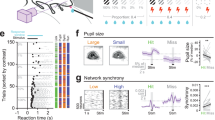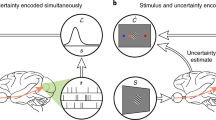Abstract
The posterior parietal cortex (PPC) has been implicated in perceptual decision-making and categorization, but whether its activity plays a causal role remains controversial. Here we examined the population dynamics of PPC activity during an auditory-guided decision task in mice. We found that silencing of PPC activity impaired several aspects of decision-making. First, categorization of new, but not well-learned, stimuli was impaired. Second, re-categorization of previously experienced stimuli based on newly learned categories was also impaired. Third, the bias on behavioral choices created by preceding trials significantly increased. In vivo two-photon imaging of PPC activity during stimulus categorization revealed differential dynamics in representations of new stimuli and learned categories, consistent with rapid incorporation of new sensory information during categorization. At the circuit level, inactivation of PPC axonal projections to the auditory cortex also significantly reduced categorization performance. Thus, PPC circuits play a causal role in decision-making during stimulus categorization.
This is a preview of subscription content, access via your institution
Access options
Access Nature and 54 other Nature Portfolio journals
Get Nature+, our best-value online-access subscription
$29.99 / 30 days
cancel any time
Subscribe to this journal
Receive 12 print issues and online access
$209.00 per year
only $17.42 per issue
Buy this article
- Purchase on Springer Link
- Instant access to full article PDF
Prices may be subject to local taxes which are calculated during checkout








Similar content being viewed by others
Data availability
All data used to understand and assess the conclusions of this study are available in the main text or supplementary materials. All the original behavioral, optogenetic, imaging and histochemical data are archived in the Institute of Neuroscience, Shanghai Institutes for Biological Sciences, Chinese Academy of Sciences, and are available from the corresponding author upon reasonable request.
Code availability
All data acquisition and analysis code are archived in the Institute of Neuroscience, Shanghai Institutes for Biological Sciences, Chinese Academy of Sciences, and are available from the corresponding author upon reasonable request.
References
Shadlen, M. N. & Newsome, W. T. Neural basis of a perceptual decision in the parietal cortex (area LIP) of the rhesus monkey. J. Neurophysiol. 86, 1916–1936 (2001).
Gold, J. I. & Shadlen, M. N. The neural basis of decision making. Annu. Rev. Neurosci. 30, 535–574 (2007).
Yang, T. & Shadlen, M. N. Probabilistic reasoning by neurons. Nature 447, 1075–1080 (2007).
Freedman, D. J. & Assad, J. A. A proposed common neural mechanism for categorization and perceptual decisions. Nat. Neurosci. 14, 143–146 (2011).
Freedman, D. J. & Assad, J. A. Neuronal mechanisms of visual categorization: an abstract view on decision making. Annu. Rev. Neurosci. 39, 129–147 (2016).
Freedman, D. J. & Assad, J. A. Experience-dependent representation of visual categories in parietal cortex. Nature 443, 85–88 (2006).
Hanks, T. D. et al. Distinct relationships of parietal and prefrontal cortices to evidence accumulation. Nature 520, 220–223 (2015).
Harvey, C. D., Coen, P. & Tank, D. W. Choice-specific sequences in parietal cortex during a virtual-navigation decision task. Nature 484, 62–68 (2012).
Runyan, C. A., Piasini, E., Panzeri, S. & Harvey, C. D. Distinct timescales of population coding across cortex. Nature 548, 92–96 (2017).
Morcos, A. S. & Harvey, C. D. History-dependent variability in population dynamics during evidence accumulation in cortex. Nat. Neurosci. 19, 1672–1681 (2016).
Raposo, D., Kaufman, M. T. & Churchland, A. K. A category-free neural population supports evolving demands during decision-making. Nat. Neurosci. 17, 1784–1792 (2014).
Wang, X.-J. Decision making in recurrent neuronal circuits. Neuron 60, 215–234 (2008).
Wong, K.-F. & Wang, X.-J. A recurrent network mechanism of time integration in perceptual decisions. J. Neurosci. 26, 1314–1328 (2006).
Wang, X.-J. Probabilistic decision making by slow reverberation in cortical circuits. Neuron 36, 955–968 (2002).
Katz, L. N., Yates, J. L., Pillow, J. W. & Huk, A. C. Dissociated functional significance of decision-related activity in the primate dorsal stream. Nature 535, 285–288 (2016).
Chen, A., Gu, Y., Liu, S., DeAngelis, G. C. & Angelaki, D. E. Evidence for a causal contribution of macaque vestibular, but not intraparietal, cortex to heading perception. J. Neurosci. 36, 3789–3798 (2016).
Erlich, J. C., Brunton, B. W., Duan, C. A., Hanks, T. D. & Brody, C. D. Distinct effects of prefrontal and parietal cortex inactivations on an accumulation of evidence task in the rat. eLife 4, e05457 (2015).
Guo, Z. V. et al. Flow of cortical activity underlying a tactile decision in mice. Neuron 81, 179–194 (2014).
Licata, A. M. et al. Posterior parietal cortex guides visual decisions in rats. J. Neurosci. 37, 4954–4966 (2017).
Driscoll, L. N., Pettit, N. L., Minderer, M., Chettih, S. N. & Harvey, C. D. Dynamic reorganization of neuronal activity patterns in parietal cortex. Cell 170, 986–999.e16 (2017).
Hwang, E. J., Dahlen, J. E., Mukundan, M. & Komiyama, T. History-based action selection bias in posterior parietal cortex. Nat. Commun. 8, 1242 (2017).
Zhang, F., Wang, L.-P., Boyden, E. S. & Deisseroth, K. Channelrhodopsin-2 and optical control of excitable cells. Nat. Methods 3, 785–792 (2006).
Chao, H.-T. et al. Dysfunction in GABA signalling mediates autism-like stereotypies and Rett syndrome phenotypes. Nature 468, 263–269 (2010).
Ohl, F. W., Scheich, H. & Freeman, W. J. Change in pattern of ongoing cortical activity with auditory category learning. Nature 412, 733–736 (2001).
Zentall, T. R., Galizio, M. & Critchfield, T. S. Categorization, concept learning, and behavior analysis: an introduction. J. Exp. Anal. Behav. 78, 237–248 (2002).
Ashby, F. G. & Ell, S. W. The neurobiology of human category learning. Trends Cogn. Sci. 5, 204–210 (2001).
Chen, T.-W. et al. Ultrasensitive fluorescent proteins for imaging neuronal activity. Nature 499, 295–300 (2013).
Xu, N. et al. Nonlinear dendritic integration of sensory and motor input during an active sensing task. Nature 492, 247–251 (2012).
Goard, M. J., Pho, G. N., Woodson, J. & Sur, M. Distinct roles of visual, parietal, and frontal motor cortices in memory-guided sensorimotor decisions. eLife 5, e13764 (2016).
Feierstein, C. E., Quirk, M. C., Uchida, N., Sosulski, D. L. & Mainen, Z. F. Representation of spatial goals in rat orbitofrontal cortex. Neuron 51, 495–507 (2006).
Hung, C. P., Kreiman, G., Poggio, T. & DiCarlo, J. J. Fast readout of object identity from macaque inferior temporal cortex. Science 310, 863–866 (2005).
Akrami, A., Kopec, C. D., Diamond, M. E. & Brody, C. D. Posterior parietal cortex represents sensory history and mediates its effects on behaviour. Nature 554, 368–372 (2018).
Bertelson, P. Serial choice reaction-time as a function of response versus signal-and-response repetition. Nature 206, 217–218 (1965).
Gold, J. I., Law, C.-T., Connolly, P. & Bennur, S. The relative influences of priors and sensory evidence on an oculomotor decision variable during perceptual learning. J. Neurophysiol. 100, 2653–2668 (2008).
Busse, L. et al. The detection of visual contrast in the behaving mouse. J. Neurosci. 31, 11351–11361 (2011).
Zingg, B. et al. Neural networks of the mouse neocortex. Cell 156, 1096–1111 (2014).
Andersen, R. A. & Buneo, C. A. Intentional maps in posterior parietal cortex. Annu. Rev. Neurosci. 25, 189–220 (2002).
Bisley, J. W. & Goldberg, M. E. Attention, intention, and priority in the parietal lobe. Annu. Rev. Neurosci. 33, 1–21 (2010).
Todd, J. J. & Marois, R. Capacity limit of visual short-term memory in human posterior parietal cortex. Nature 428, 751–754 (2004).
Pesaran, B., Pezaris, J. S., Sahani, M., Mitra, P. P. & Andersen, R. A. Temporal structure in neuronal activity during working memory in macaque parietal cortex. Nat. Neurosci. 5, 805–811 (2002).
Buschman, T. J. & Miller, E. K. Top-down versus bottom-up control of attention in the prefrontal and posterior parietal cortices. Science 315, 1860–1862 (2007).
Corbetta, M., Kincade, J. M., Ollinger, J. M., McAvoy, M. P. & Shulman, G. L. Voluntary orienting is dissociated from target detection in human posterior parietal cortex. Nat. Neurosci. 3, 292–297 (2000).
Behrmann, M., Geng, J. J. & Shomstein, S. Parietal cortex and attention. Curr. Opin. Neurobiol. 14, 212–217 (2004).
Rosch, E. Principles of categorization. in Cognition and Categorization (eds. Rosch, E. & Lloyd, B.B.) 28–49 (L. Erlbaum Associates, 1978).
Znamenskiy, P. & Zador, A. M. Corticostriatal neurons in auditory cortex drive decisions during auditory discrimination. Nature 497, 482–485 (2013).
Guo, Z. V. et al. Procedures for behavioral experiments in head-fixed mice. PLoS One 9, e88678 (2014).
Wichmann, F. A. & Hill, N. J. The psychometric function: I. Fitting, sampling, and goodness of fit. Percept. Psychophys. 63, 1293–1313 (2001).
Pologruto, T. A., Sabatini, B. L. & Svoboda, K. ScanImage: flexible software for operating laser scanning microscopes. Biomed. Eng. OnLine 2, 13 (2003).
Guizar-Sicairos, M., Thurman, S. T. & Fienup, J. R. Efficient subpixel image registration algorithms. Opt. Lett. 33, 156–158 (2008).
Green, D. M. & Swets, J. A. Signal Detection Theory and Psychophysics (John Wiley and Sons, 1966).
Acknowledgements
We thank R. Egnor for advice on auditory behavioral apparatus, A. Kerlin for communication on behavioral control software, N. Andersen for pilot optogenetic experiments, T.T. Zhou for technical support, L. Cui, S. Tang and J. Xiao for helping with behavior training, Y. Xin for discussions on data analysis, ION Gene-editing Core Facility for providing the adeno-associated viruses and M.M. Poo for comments on the manuscript. This work was supported by Key Research Program of Frontier Sciences, CAS (grant No. QYZDB-SSW-SMC045), National Natural Science Foundation of China (grant No. 31571081), the Strategic Priority Research Program of the Chinese Academy of Sciences (grant No. XDB32010000), National Key R&D Program of China (grant Nos. 2017YFA0103900/2017YFA0103901), Shanghai Municipal Science and Technology Major Project (grant No. 2018SHZDZX05) and the Youth Thousand Talents Plan (to N.L.X.). C.A.D. is supported by the Simons Collaboration on the Global Brain Postdoctoral Fellowship and the CPSF-CAS Joint Foundation for Excellent Postdoctoral Fellows.
Author information
Authors and Affiliations
Contributions
L.Z. and N.L.X. conceived the project and designed the experiments. L.Z. performed all the experiments and data analysis. Y.Z. performed the axon inactivation experiments. L.Z. and C.A.D. conceived and performed the GLMM analysis. J.D. collected part of the behavioral data. L.Z., J.P. and N.L.X. developed the hardware and software for the behavior and imaging system. L.Z. and N.L.X. wrote the manuscript with contributions from C.A.D and Y.Z.
Corresponding author
Ethics declarations
Competing interests
The authors declare no competing interests.
Additional information
Journal peer review information Nature Neuroscience thanks Jonathan Whitlock and the other anonymous reviewer(s) for their contribution to the peer review of this work.
Publisher’s note: Springer Nature remains neutral with regard to jurisdictional claims in published maps and institutional affiliations.
Supplementary information
41593_2019_383_MOESM3_ESM.mov
Supplementary Video 1 Example of behavioral performance from a session with optogenetic silencing of PPC. The mouse was trained to report categorical decisions on low- or high-frequency tones by licking the left or right lickport. During a session of photoinhibition (optogenetic silencing of PPC), photoinhibition trials (blue light stimulation of bilateral PPC plus LED mask light, ‘optostim + LED’, trials 3 and 5 in the video) were randomly interleaved with control trials (‘LED only’, trials 1, 2 and 4 in the video).
Rights and permissions
About this article
Cite this article
Zhong, L., Zhang, Y., Duan, C.A. et al. Causal contributions of parietal cortex to perceptual decision-making during stimulus categorization. Nat Neurosci 22, 963–973 (2019). https://doi.org/10.1038/s41593-019-0383-6
Received:
Accepted:
Published:
Issue Date:
DOI: https://doi.org/10.1038/s41593-019-0383-6
This article is cited by
-
Synaptic wiring motifs in posterior parietal cortex support decision-making
Nature (2024)
-
Behavior-relevant top-down cross-modal predictions in mouse neocortex
Nature Neuroscience (2024)
-
Automating licking bias correction in a two-choice delayed match-to-sample task to accelerate learning
Scientific Reports (2023)
-
Emergence of cortical network motifs for short-term memory during learning
Nature Communications (2023)
-
Nigrostriatal dopamine modulates the striatal-amygdala pathway in auditory fear conditioning
Nature Communications (2023)



